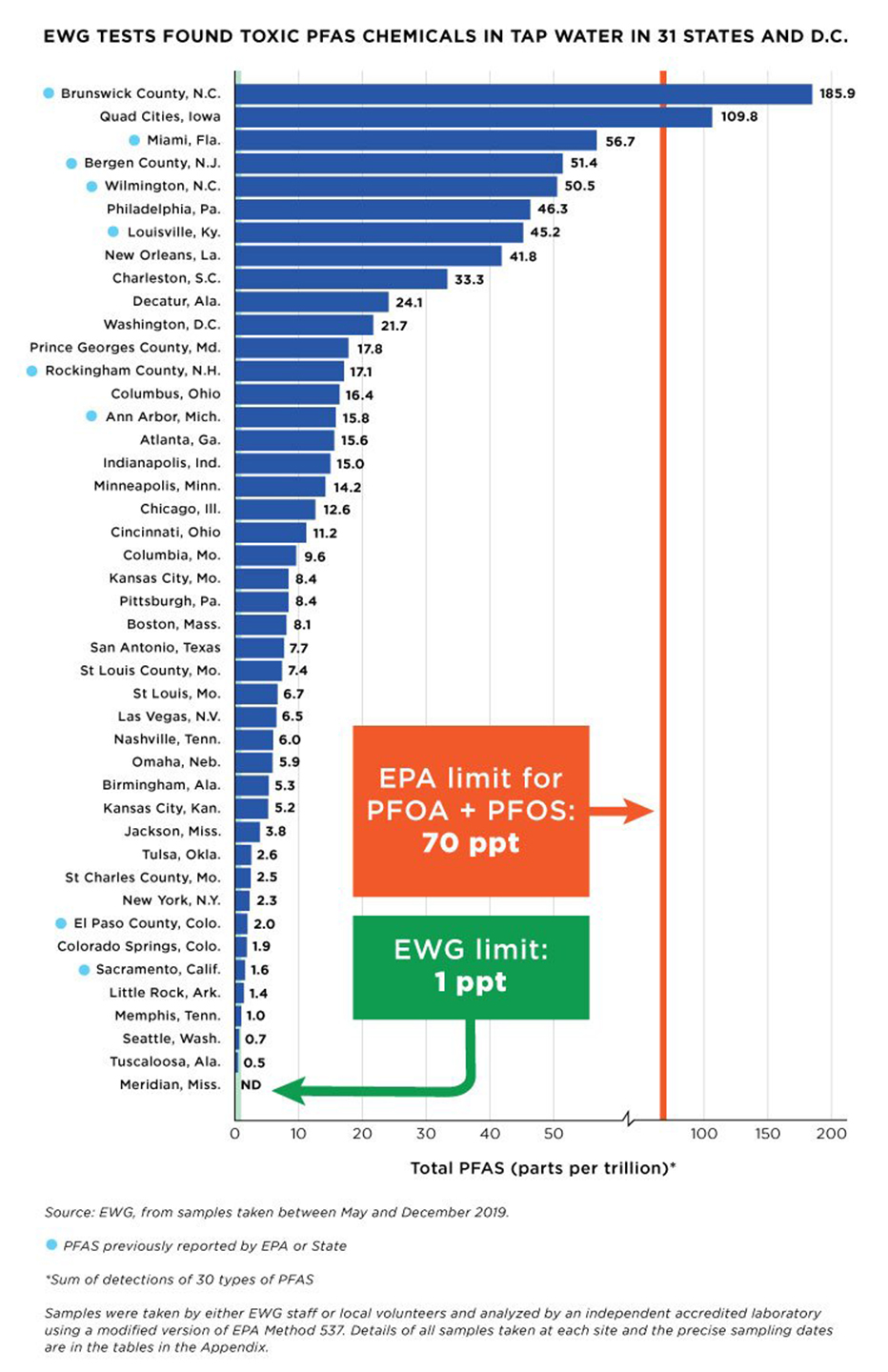PFAS Contamination: Nearly 100 Million Americans Affected, Study Finds

Table of Contents
The Scope of PFAS Contamination Across the US
PFAS contamination isn't confined to a single region; it's a nationwide problem. Interactive maps illustrating affected areas show a disturbing pattern of contamination, with hotspots concentrated across various states. Areas with a history of industrial activity, military bases (due to the use of firefighting foam), and agricultural practices often exhibit higher levels of PFAS in their water supplies. This widespread presence raises serious concerns about the accessibility of clean, safe drinking water for millions.
- Specific states with high levels of PFAS contamination: Michigan, New Hampshire, New Jersey, and California are among the states reporting significant PFAS contamination incidents in both public water systems and private wells.
- Types of water sources most frequently contaminated: Public water systems, serving numerous communities, are frequently affected. However, private wells are particularly vulnerable due to their proximity to potential sources of contamination. This makes rural communities especially susceptible.
- Geographical distribution of contamination: While urban areas can certainly experience PFAS contamination, the impact on rural communities is often more significant due to the reliance on private wells and the potential proximity to industrial sites or agricultural lands.
Health Risks Associated with PFAS Exposure
The health consequences associated with PFAS exposure are deeply concerning. Studies have linked PFAS exposure to a range of adverse health effects, including: liver cancer, thyroid disorders, immune deficiency, and developmental issues in children. Even low-level, long-term exposure can have significant impacts. Pregnant women and children are particularly vulnerable to the harmful effects of PFAS, as they are more susceptible to the toxic effects of these persistent chemicals.
- Specific health problems linked to PFAS: These range from immune system dysfunction to increased cholesterol levels, infertility, and certain types of cancer. The long-term effects are still being studied, but the evidence strongly suggests a link between PFAS exposure and serious health complications.
- Studies showing correlations between PFAS exposure and adverse health outcomes: Numerous peer-reviewed studies have documented a clear correlation between elevated PFAS levels in blood serum and the occurrence of various diseases. These studies provide strong evidence supporting the need for immediate action.
- Long-term health consequences that may not be immediately apparent: The insidious nature of PFAS lies in its long-term effects. Damage may not become apparent for years, making early detection and preventative measures crucial.
Sources and Pathways of PFAS Contamination
PFAS contamination stems from various sources, highlighting the complexity of the problem. Industrial discharges from factories producing PFAS-containing products, the use of aqueous film-forming foam (AFFF) at military bases and airports, and the presence of PFAS in non-stick cookware and other consumer products all contribute to the widespread pollution. These chemicals are incredibly persistent, resisting degradation in the environment and accumulating in the food chain – a process called bioaccumulation.
- Specific industries contributing to PFAS contamination: Manufacturing of fluoropolymers, textile coatings, and firefighting foam production are among the major contributors to PFAS pollution.
- Examples of consumer products containing PFAS: Non-stick cookware, stain-resistant fabrics, and food packaging have all been identified as sources of PFAS exposure through direct contact or ingestion.
- The process of PFAS migration from source to water systems: PFAS can leach into the soil and groundwater, ultimately contaminating drinking water supplies through various pathways. This makes it challenging to pinpoint the exact source of contamination in many cases.
Addressing PFAS Contamination: Solutions and Prevention
Addressing PFAS contamination requires a multi-pronged approach encompassing technological solutions, regulatory efforts, and individual actions. Several remediation technologies are available, including granular activated carbon (GAC) filtration systems that can effectively remove PFAS from drinking water. However, the cost and feasibility of such systems vary depending on the scale of contamination. Legislators are working on stricter regulations and setting maximum contaminant levels (MCLs) for PFAS in drinking water, but consistent and widespread implementation remains a challenge. We also need increased funding for research and improved testing capabilities to fully understand this multifaceted contamination challenge.
- Effective water filtration systems for removing PFAS: Granular activated carbon (GAC) filters are commonly used, but reverse osmosis (RO) systems can also effectively remove PFAS. The choice of filtration system depends on the level of contamination and the budget.
- Current and proposed regulations at the federal and state levels: The EPA is actively working on establishing national standards for PFAS, but numerous states have already implemented their own regulations.
- Simple steps individuals can take to minimize their exposure: Choosing PFAS-free alternatives when purchasing cookware and other consumer products, using water filters at home, and supporting legislation to reduce PFAS pollution can all make a difference.
Conclusion: Taking Action Against PFAS Contamination
The pervasive nature of PFAS contamination, coupled with its serious health risks, necessitates immediate and sustained action. The fact that nearly 100 million Americans may be exposed highlights the urgent need for comprehensive solutions. Addressing PFAS contamination requires a coordinated effort involving government agencies, industries, and individuals. By understanding the sources, pathways, and health risks associated with PFAS, we can work towards effective PFAS prevention and remediation strategies. Learn more about PFAS testing options in your area, advocate for stricter regulations on PFAS, and explore PFAS solutions like water filtration systems to protect yourself and your family. Visit the EPA website and other health organizations for more information on PFAS and how to protect yourself. Don't delay; take action against PFAS contamination today.

Featured Posts
-
 Npo Vertrouwen College Van Omroepen Werkt Aan Herstel
May 15, 2025
Npo Vertrouwen College Van Omroepen Werkt Aan Herstel
May 15, 2025 -
 Jury Finds Man Guilty In 2023 Warner Robins Murder
May 15, 2025
Jury Finds Man Guilty In 2023 Warner Robins Murder
May 15, 2025 -
 Ohio City Apartment Shooting Leaves One Injured
May 15, 2025
Ohio City Apartment Shooting Leaves One Injured
May 15, 2025 -
 San Jose Earthquakes Scouting Report Tactical Analysis And Player Profiles
May 15, 2025
San Jose Earthquakes Scouting Report Tactical Analysis And Player Profiles
May 15, 2025 -
 Kaysima Kyproy Poy Tha Breite Tis Xamiloteres Times
May 15, 2025
Kaysima Kyproy Poy Tha Breite Tis Xamiloteres Times
May 15, 2025
Latest Posts
-
 12 7
May 16, 2025
12 7
May 16, 2025 -
 The 1 Debt Tom Cruises Unpaid Role To Tom Hanks
May 16, 2025
The 1 Debt Tom Cruises Unpaid Role To Tom Hanks
May 16, 2025 -
 7 12
May 16, 2025
7 12
May 16, 2025 -
 Tom Hanks And Tom Cruise A 1 Debt That Still Remains Unsettled
May 16, 2025
Tom Hanks And Tom Cruise A 1 Debt That Still Remains Unsettled
May 16, 2025 -
 Tom Cruises Unpaid Debt To Tom Hanks The 1 Role He Never Played
May 16, 2025
Tom Cruises Unpaid Debt To Tom Hanks The 1 Role He Never Played
May 16, 2025
